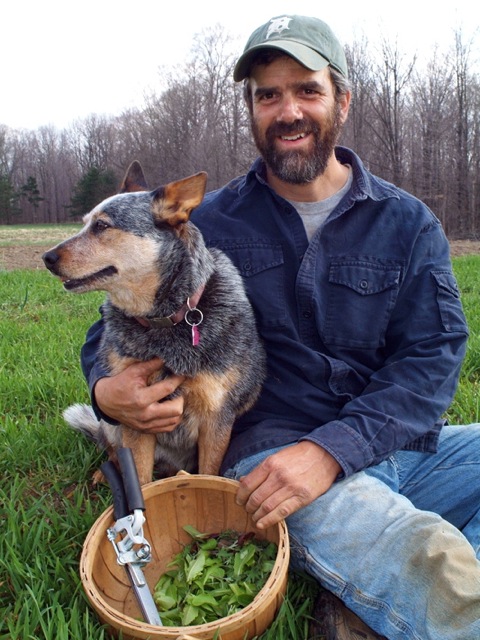
reference-image, l
(article, Karen Stillerman)
[%pageBreakSettings nobreak=true] Last year the [%bookLink code=0195170776 "New Oxford American Dictionary"] named “locavore” — a person who tries to eat mostly locally produced food — as its word of the year. You may have never encountered the word locavore before. But it's getting a lot easier to be one, thanks to forward-thinking farms and growing consumer and commercial demand. Dennis Wilcox’s farm is a prime example of one of those farms. His 30 acres in Bangor, Michigan, have been managed organically for decades, and he’s still making improvements. He doesn’t use toxic pesticides or synthetic fertilizers. Drip irrigation lines conserve precious water. Half of the farm is wooded, which provides wildlife habitat and protects the land from erosion. "High tunnel" structures extend his growing season instead of greenhouses heated with fossil fuels. And his entire farm, including a house he is building on the property, is solar powered and “off the grid.” [%image dennis float=left width=300 caption="Dennis Wilcox on his farm."] “I feel lucky,” Wilcox says about farming this way. “I get to work outside, be my own boss, and do something I'm good at while also doing something good for our community.” As a small local grower, Wilcox enjoys interacting directly with his customers. One of those customers is chef Julie Stanley, who owns the Food Dance Café down the road in Kalamazoo. She has been buying salad greens and other produce from Wilcox for years, preferring their freshness and flavor to what national distributors offer. The Union of Concerned Scientists recently profiled Wilcox and Stanley as part of an online effort to highlight farmers and chefs who are joining forces to grow and serve sustainable food. Our “Green Cuisine” project has discovered that the Wilcox-Stanley “partnership” is being replicated elsewhere, sparked by consumers seeking alternatives to an industrialized food system that provides abundant but often tasteless food. By demanding more local, sustainably grown fruits, vegetables, grains, dairy products, and meat, Americans are changing the food landscape. Just one indication is the fact that since the early 1990s, the number of local farmers' markets across the country has more than doubled. Likewise, community-supported agriculture, where consumers buy “shares” of a local farm’s yearly harvest, has grown by more than 2,000 percent over the same time. Large corporations also are helping drive demand. For example, Bon Appétit Management Company, a food-service firm that serves more than 80 million meals annually, finds local and sustainable foods for its clients, which include Cisco Systems, Target, the Art Institute of Chicago, the San Francisco Giants baseball stadium, and a number of colleges and universities. Kaiser-Permanente, the largest U.S. health-care provider, hosts farmers' markets at some of its facilities and works with local growers to put fresh produce on in-patient meal trays at 19 of its California hospitals. But even with growing consumer and commercial demand, it will take far more than individual buying decisions to significantly improve U.S. agricultural practices. Our country's food system will have to undergo a dramatic transformation to move from highly concentrated, over-subsidized, commodity-focused industrial agriculture to a system that better protects the environment and public health and better serves local communities. Congress recently passed a farm bill that takes at least one step in the right direction. The bill — the Food, Conservation and Energy Act of 2008 (PDF) — is dominated by outmoded, unjustified farm subsidies. But buried deep in the fine print of this voluminous bill are several positive provisions for the future of farming and our food system. For example, the legislation sets aside substantial funding for farmland conservation efforts, an increase of more than a billion dollars per year. It also promotes organic farming by providing for more research and data collection, which will help farmers, scientists, and regulators understand how best to grow and market organic foods; directing new technical and financial support to farmers transitioning from conventional to organic production; and dramatically increasing a cost-share program in which the government helps small farmers cover the cost of organic certification fees. The new farm bill also will help communities develop more local and sustainable food choices. It increases funding for local organizations to establish and promote farmers' markets, and provides grants for local projects that improve access for communities to healthy, affordable foods. Additionally, the bill makes it easier for public schools to purchase locally produced foods. [%image reference-image float=left width=400 caption="Antibiotic-free, pasture-raised cattle."] Finally, the legislation establishes a new program to fund research on the link between antibiotic use in industrialized animal agriculture and resistant bacteria, which are difficult and costly to treat when they infect people. An estimated 70 percent of all antibiotics and related drugs used in the United States are given to food animals, mainly to promote faster growth and to stave off diseases in massive confined animal feeding operations, or CAFOs. These facilities, which crowd thousands of animals together under stressful conditions, are far more likely than small and mid-size producers to abuse antibiotics. Organic farmers don’t use them at all. UCS and many other organizations advocated for these and other provisions that will help farmers, the environment, and consumers alike. But the bill could have done a lot more. When it comes up for debate again in five years, we will need to push harder to shift federal research and funding priorities toward sustainable food systems. In the meantime, we should support such farmers and business as Dennis Wilcox and the Food Dance Café by shopping at farmers' markets, looking for local and organic foods on restaurant menus and in supermarket aisles, and joining community-supported agriculture programs. Buying sustainably grown food in our own communities and regions can help ensure that our food is as fresh, nutritious, delicious, and environmentally friendly as it can be. p(bio). Karen Perry Stillerman is a senior analyst with the Food and Environment Program at the Union of Concerned Scientists.

reference-image, l

dennis, l